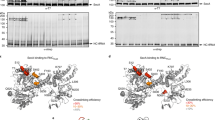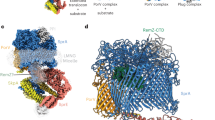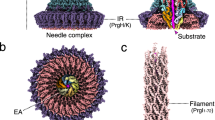Abstract
In Gram-negative bacteria, two distinct targeting routes assist in the proper localization of secreted and membrane proteins. Signal recognition particle (SRP) mainly targets ribosome-bound nascent membrane proteins, whereas SecB facilitates the targeting of periplasmic and outer membrane proteins. These routes converge at the translocase, a protein-conducting pore in the membrane that consists of the SecYEG complex associated with the peripheral ATPase, SecA. Recent structural studies of the targeting and the translocating components provide insights into how substrates are recognized and suggest a mechanism by which proteins are transported through an aqueous pore in the cytoplasmic membrane.
This is a preview of subscription content, access via your institution
Access options
Subscribe to this journal
Receive 12 print issues and online access
$189.00 per year
only $15.75 per issue
Buy this article
- Purchase on Springer Link
- Instant access to full article PDF
Prices may be subject to local taxes which are calculated during checkout





Similar content being viewed by others
References
Herskovits, A.A., Bochkareva, E.S. & Bibi, E. New prospects in studying the bacterial signal recognition particle pathway. Mol. Microbiol. 38, 927–939 (2000).
Fekkes, P. & Driessen, A.J.M. Protein targeting to the bacterial cytoplasmic membrane. Microbiol. Mol. Biol. Rev. 63, 161–173 (1999).
Beck, K., Wu, L.F., Brunner, J. & Müller, M. Discrimination between SRP- and SecA/SecB-dependent substrates involves selective recognition of nascent chains by SRP and trigger factor. EMBO J. 19, 134–143 (2000).
Valent, Q.A. et al. The Escherichia coli SRP and SecB targeting pathways converge at the translocon. EMBO J. 17, 2504–2512 (1998).
Manting, E.H. & Driessen, A.J.M. Escherichia coli translocase: the unraveling of a molecular machine. Mol. Microbiol. 37, 226–238 (2000).
Prinz, A., Behrens, C., Rapoport, T.A., Hartmann, E. & Kalies, K.U. Evolutionarily conserved binding of ribosomes to the translocation channel via the large ribosomal RNA. EMBO J. 19, 1900–1906 (2000).
Scotti, P.A. et al. YidC, the Escherichia coli homologue of mitochondrial Oxa1p, is a component of the Sec translocase. EMBO J. 19, 542–549 (2000).
Duong, F. & Wickner, W. The SecDFyajC domain of preprotein translocase controls preprotein movement by regulating SecA membrane cycling. EMBO J. 16, 4871–4879 (1997).
Hartmann, E. et al. Evolutionary conservation of components of the protein translocation complex. Nature 367, 654–657 (1994).
Johnson, A.E. & van Waes, M.A. The translocon: a dynamic gateway at the ER membrane. Annu. Rev. Cell Dev. Biol. 15, 799–842 (1999).
Hell, K., Neupert, W. & Stuart, R.A. Oxa1p acts as a general membrane insertion machinery for proteins encoded by mitochondrial DNA. EMBO J. 20, 1281–1288 (2001).
Samuelson, J.C. et al. YidC mediates membrane protein insertion in bacteria. Nature 406, 637–641 (2000).
Walter, P. & Johnson, A.E. Signal sequence recognition and protein targeting to the endoplasmic reticulum membrane. Annu. Rev. Cell Biol. 10, 87–119 (1994).
Powers, T. & Walter, P. Reciprocal stimulation of GTP hydrolysis by two directly interacting GTPases. Science 269, 1422–1424 (1995).
Zheng, N. & Gierasch, L.M. Domain interactions in E. coli SRP: stabilization of M domain by RNA is required for effective signal sequence modulation of NG domain. Mol. Cell 1, 79–87 (1997).
Peluso, P. et al. Role of 4.5S RNA in assembly of the bacterial signal recognition particle with its receptor. Science 288, 1640–1643 (2000).
Neumann-Haefelin, C., Schafer, U., Muller, M. & Koch, H.G. SRP-dependent co-translational targeting and SecA-dependent translocation analyzed as individual steps in the export of a bacterial protein. EMBO J. 19, 6419–6426 (2000).
Freymann, D.M., Keenan, R.J., Stroud, R.M. & Walter, P. Structure of the conserved GTPase domain of the signal recognition particle. Nature 385, 361–364 (1997).
Keenan, R.J., Freymann, D.M., Walter, P. & Stroud, R.M. Crystal structure of the signal sequence binding subunit of the signal recognition particle. Cell 94, 181–191 (1998).
Freymann, D.M., Keenan, R.J., Stroud, R.M. & Walter, P. Functional changes in the structure of the SRP GTPase on binding GDP and Mg2+GDP. Nature. Struct. Biol. 6, 793–801 (1999).
Batey, R.T., Rambo, R.P., Lucast, L., Rha, B. & Doudna, J.A. Crystal structure of the ribonucleoprotein core of the signal recognition particle. Science 287, 1232–1239 (2000).
Montoya, G., Svensson, C., Luirink, J. & Sinning, I. Crystal structure of the NG domain from the signal-recognition particle receptor FtsY. Nature 385, 365–368 (1997).
Moser, C., Mol, O., Goody, R.S. & Sinning, I. The signal recognition particle receptor of Escherichia coli (FtsY) has a nucleotide exchange factor built into the GTPase domain. Proc. Natl. Acad. Sci. USA 94, 11339–11344 (1997).
Kumamoto, C.A. & Francetiç, O. Highly selective binding of nascent polypeptides by an Escherichia coli chaperone protein in vivo. J. Bacteriol. 175, 2184–2188 (1993).
Hartl, F.U., Lecker, S., Schiebel, E., Hendrick, J.P. & Wickner, W. The binding cascade of SecB to SecA to SecY/E mediates preprotein targeting to the E. coli plasma membrane. Cell 63, 269–279 (1990).
Park, S., Liu, G., Topping, T.B., Cover, W.H. & Randall, L.L. Modulation of folding pathways of exported proteins by the leader sequence. Science 239, 1033–1035 (1988).
Fekkes, P., van der Does, C. & Driessen, A.J.M. The molecular chaperone SecB is released from the carboxy-terminus of SecA during initiation of precursor protein translocation. EMBO J. 16, 6105–6113 (1997).
Xu, Z., Knafels, J.D. & Yoshino, K. Crystal structure of the bacterial protein export chaperone SecB. Nature Struct. Biol. 7, 1172–1177 (2000).
Muren, E.M., Suciu, D., Topping, T.B., Kumamoto, C.A. & Randall, L.L. Mutational alterations in the homotetrameric chaperone SecB that implicate the structure as dimer of dimers. J. Biol. Chem. 274, 19397–19402 (1999).
Knoblauch, N.T. et al. Substrate Specificity of the SecB Chaperone. J. Biol. Chem. 274, 34219–34225 (1999).
Randall, L.L., Topping, T.B., Suciu, D. & Hardy, S.J. Calorimetric analyses of the interaction between SecB and its ligands. Protein Sci. 7, 1195–1200 (1998).
Hardy, S.J. & Randall, L.L. A kinetic partitioning model of selective binding of nonnative proteins by the bacterial chaperone SecB. Science 251, 439–443 (1991).
Topping, T.B. & Randall, L.L. Determination of the binding frame within a physiological ligand for the chaperone SecB. Protein Sci. 3, 730–736 (1994).
Fekkes, P. et al. Preprotein transfer to the Escherichia coli translocase requires the cooperative binding of SecB and the signal sequence to SecA. Mol. Microbiol. 29, 1179–1190 (1998).
Kawasaki, S., Mizushima, S. & Tokuda, H. Membrane vesicles containing overproduced SecY and SecE exhibit high translocation ATPase activity and countermovement of protons in a SecA- and presecretory protein-dependent manner. J. Biol. Chem. 268, 8193–8198 (1993).
Joly, J.C. & Wickner, W. The SecA and SecY subunits of translocase are the nearest neighbors of a translocating preprotein, shielding it from phospholipids. EMBO J. 12, 255–263 (1993).
van Voorst, F., van der Does, C., Brunner, J., Driessen, A.J.M. & de Kruijff, B. Translocase-bound SecA is largely shielded from the phospholipid acyl chains. Biochemistry 37, 12261–12268 (1998).
Schiebel, E., Driessen, A.J.M., Hartl, F.U. & Wickner, W. ΔμH+ and ATP function at different steps of the catalytic cycle of preprotein translocase. Cell 64, 927–939 (1991).
van der Wolk, J.P., de Wit, J.G. & Driessen, A.J.M. The catalytic cycle of the Escherichia coli SecA ATPase comprises two distinct preprotein translocation events. EMBO J. 16, 7297–7304 (1997).
Economou, A. & Wickner, W. SecA promotes preprotein translocation by undergoing ATP-driven cycles of membrane insertion and deinsertion. Cell 78, 835–843 (1994).
Kaufmann, A., Manting, E.H., Veenendaal, A.K., Driessen, A.J.M. & van der Does, C. Cysteine-directed cross-linking demonstrates that helix 3 of SecE is close to helix 2 of SecY and helix 3 of a neighboring SecE. Biochemistry 38, 9115–9125 (1999).
Hanein, D. et al. Oligomeric rings of the Sec61p complex induced by ligands required for protein translocation. Cell 87, 721–732 (1996).
Beckmann, R. et al. Alignment of conduits for the nascent polypeptide chain in the ribosome-Sec61 complex. Science 278, 2123–2126 (1997).
Ménétret, J. et al. The structure of ribosome-channel complexes engaged in protein translocation. Mol. Cell 6, 1219–1232 (2000).
Meyer, T.H. et al. The bacterial SecY/E translocation complex forms channel-like structures similar to those of the eukaryotic Sec61p complex. J. Mol. Biol. 285, 1789–1800 (1999).
Hamman, B.D., Chen, J.C., Johnson, E.E. & Johnson, A.E. The aqueous pore through the translocon has a diameter of 40–60 Å during cotranslational protein translocation at the ER membrane. Cell 89, 535–544 (1997).
Tani, K., Tokuda, H. & Mizushima, S. Translocation of ProOmpA possessing an intramolecular disulfide bridge into membrane vesicles of Escherichia coli. Effect of membrane energization. J. Biol. Chem. 265, 17341–17347 (1990).
Manting, E.H., van der Does, C., Remigy, H., Engel, A. & Driessen, A.J.M. SecYEG assembles into a tetramer to form the active protein translocation channel. EMBO J. 19, 852–861 (2000).
Karamanou, S. et al. A molecular switch in SecA protein couples ATP hydrolysis to protein translocation. Mol. Microbiol. 34, 1133–1145 (1999).
Nakatogawa, H., Mori, H. & Ito, K. Two independent mechanisms down-regulate the intrinsic SecA ATPase activity. J. Biol. Chem. 275, 33209–33212 (2000).
Eichler, J. & Wickner, W. Both an N-terminal 65-kDa domain and a C-terminal 30-kDa domain of SecA cycle into the membrane at SecYEG during translocation. Proc. Natl. Acad. Sci. USA 94, 5574–5581 (1997).
Ramamurthy, V. & Oliver, D. Topology of the integral membrane form of Escherichia coli SecA protein reveals multiple periplasmically exposed regions and modulation by ATP binding. J. Biol. Chem. 272, 23239–23246 (1997).
van der Does, C., Manting, E.H., Kaufmann, A., Lutz, M. & Driessen, A.J.M. Interaction between SecA and SecYEG in micellar solution and formation of the membrane-inserted state. Biochemistry 37, 201–210 (1998).
Shilton, B. et al. Escherichia coli SecA shape and dimensions. FEBS Lett. 436, 277–282 (1998).
Yahr, T.L. & Wickner, W.T. Evaluating the oligomeric state of SecYEG in preprotein translocase. EMBO J. 19, 4393–4401 (2000).
Acknowledgements
We would like to thank A. Mark and N. Nouwen for careful reading of the manuscript, and the past and present members of the team who contributed to this work. This work was supported by the Earth and Life Sciences Foundation (Algemene Levenswetenschappen, ALW), the Netherlands Foundation for Chemical Research (Chemische Wetenschappen, CW), and the Netherlands Foundation for Scientific Research (Nederlandse Wetenschappelijk Onderzoek, NWO).
Author information
Authors and Affiliations
Corresponding author
Rights and permissions
About this article
Cite this article
Driessen, A., Manting, E. & van der Does, C. The structural basis of protein targeting and translocation in bacteria. Nat Struct Mol Biol 8, 492–498 (2001). https://doi.org/10.1038/88549
Received:
Accepted:
Issue Date:
DOI: https://doi.org/10.1038/88549
This article is cited by
-
Principle and potential applications of the non-classical protein secretory pathway in bacteria
Applied Microbiology and Biotechnology (2020)
-
Secretory production of a beta-mannanase and a chitosanase using a Lactobacillus plantarum expression system
Microbial Cell Factories (2016)
-
OmpA signal peptide leads to heterogenous secretion of B. subtilis chitosanase enzyme from E. coli expression system
SpringerPlus (2016)
-
Lipid exposure prediction enhances the inference of rotational angles of transmembrane helices
BMC Bioinformatics (2013)
-
Biogenesis of bacterial inner-membrane proteins
Cellular and Molecular Life Sciences (2010)



